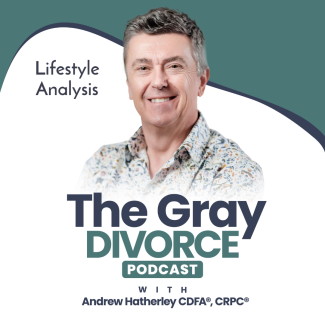
The Gray Divorce Podcast: Episode 9 Lifestyle Analysis
Episode nine of The Gray Divorce Podcast deals with the topic of lifestyle analysis in divorce. Lifestyle analysis is a very useful tool for divorce attorneys in cases where one party has a substantial claim for spousal support. Essentially, the lifestyle analysis establishes the standard of living of a couple in marriage. It's a very detailed look at the income and day-to-day expenses incurred during the marriage and looks closely at the spending habits of both parties.
A lifestyle analysis might be referred to as a budget on steroids. Typically, a lifestyle analysis is done in a high-net-worth divorce case. Discretionary expenses such as luxury travel, high-end restaurants, and private club memberships are typically tabulated in a lifestyle analysis.
It’s not unusual for a lifestyle analysis in divorce to tabulate thousands or even 10s of thousands of individual transactions.
The analysis typically includes a review of:
- all financial statements including bank, brokerage, and retirement accounts.
- several years of personal and business income tax returns.
- loan or refinancing applications.
- credit reports.
A lifestyle analysis typically reviews the last several years of marriage. At least two years of expenses are needed to provide a reliable indicator of marital lifestyle. It's not unusual to gather three to five years of data prior to separation.
Hidden Income
The lifestyle analysis in divorce can also be very helpful in confirming income claims made by a spouse. Quite often in divorce one spouse, typically the business owner or major breadwinner pleads poverty. A lifestyle analysis may uncover undisclosed sources of income or point to areas of further investigation.
Common methods of hiding income might include:
• intentional underreporting of income on the income tax return.
• under the table cash payments made as a way of hiding income from the IRS and the spouse.
• offshore bank accounts.
Transcript
Announcement: Welcome to The Gray Divorce Podcast, hosted by divorce financial analyst and retirement planning counselor Andrew Hatherley. Join Andrew and guest experts as they help late-life divorcees build the financial and mental foundation for a meaningful future. There is life after divorce. Now on to the show.
Andrew Hatherley: Hi everybody, today's episode is just me and it's going to be a short episode - short but mighty, and I'm going to be discussing the very important topic of Lifestyle Analysis. Now Lifestyle Analysis is a tool that divorce financial analysts provide to attorneys in divorce cases.
A lifestyle analysis essentially establishes the standard of living of a couple in marriage. It looks at the income and day-to-day living expenses incurred during the marriage and the spending habits of both parties.
The purpose of a Lifestyle analysis is primarily to support one party’s claim for spousal support. but lifestyle analysis can often provide an added benefit in uncovering hidden sources of income or uncover hidden assets.
So, what is a lifestyle analysis and and what does it do?
I like to think of a lifestyle analysis as a budget on steroids. By that I mean that a lifestyle analysis is typically done in a divorce case where the parties have significant assets. One of the things about budgets is that we're often surprised when we categorize our expenses to see that we're spending so much money on a particular item. I suppose the cliched expense item that might surprise us is a $5 latte. If asked, we may answer that we may spend 20 or $30 a month on fancy coffees. But let's face it some of us buy these fancy coffees five or six times a week which adds up to about a $1,200 a year Starbucks habit. Well, the steroids part of the lifestyle analysis refers to a lot more and a lot higher expenses.
Whether it be private club memberships, high end travel, high end restaurants,…I've seen budgets exceed $100,000 for each of these categories.
A lifestyle analysis is a very detailed analysis of marital financial statements. It’s not unusual to tabulate 1000s or even 10s of thousands of individual transactions:
This analysis would typically include:
- all financial statements, including bank, brokerage, retirement accounts and credit card statements.
- it would include several years personal and business income tax returns.
- I always request refinancing or loan application paperwork which can often be a treasure trove of financial information.
- and the credit report is helpful also.
- and It's important to look at extraordinary or nonrecurring expenses. One-off special occurrences which may not be a part of the ongoing marital budget
As I mentioned at the outset, lifestyle analysis is primarily used in divorce cases where there will be a spousal support claim by one of the parties. That party's attorney and other members of the team such as the divorce financial analyst can use the lifestyle analysis as the basis to calculate a dollar amount that their client would need to maintain a similar lifestyle after the divorce.
So, the lifestyle analysis gives us a more accurate picture of how much money is needed to maintain one party's standard of living. If the divorce proceedings end up going to court the details in the analysis will provide a valuable reference point for a judge in helping him or her determine the property division and the amount and duration of spousal support or alimony.
A lifestyle analysis typically emphasizes the last several years of marriage. Typically, at least two years of expenses are needed to provide a reliable gauge of marital lifestyle. And it's common that three to five years of data prior to separation will be gathered to reliably predict future income and expenses.
This can mean that the analysis can involve compiling, categorizing and analyzing thousands, sometimes 10s of thousands, of entries related to expenses.
I referred to the lifestyle analysis as a budget on steroids and you can imagine that the compilation, categorization and analysis of thousands, of entries is a long and involved process. And it's not cheap. The cost can range widely just like all the other variable costs in divorce.
Sometimes the time will be reduced to limit the cost and scope of the work. I would certainly not recommend analyzing less than two years of data. It is necessary to establish a history and pattern of spending. There is also the danger that in analyzing a shorter time period any unusual or extraordinary income or expense items would skew the results of the analysis.
Now, the vast majority of divorce cases do not incorporate a lifestyle analysis. Most cases do not have the level of complexity or financial resources requiring this level of detailed work.
Despite the cost, my experience is that a good lifestyle analysis properly used in the right situation will pay for itself many times over, by justifying a spousal support claim or shedding light on certain income and expenses or potentially missing income.
Lifestyle analysis can also be very helpful in refuting or confirming income claims made by a spouse. For instance, a spouse may plead poverty yet live a lifestyle that is quite lavish compared to his or her claims of their own income. In this way a lifestyle analysis may suggest to us that there are undisclosed sources of income and that a deeper investigation is needed.
Some common methods of hiding income include:
- intentional underreporting of income on the income tax return
- Cash payments that are made under the table as a way of hiding income from the IRS and your spouse
- and, Of course, the old standby, the offshore bank accounts can be used to hide income and the assets that build the accounts.
When one of the parties owns a business it's not uncommon to see business funds being used to pay personal expenses and then categorize those personal expenses as business expenses.
Typical personal expenses that may be improperly categorized as business expenses might include: travel, meals, entertainment. car leases, private club memberships and private school tuition.
By classifying these personal expenses as business expenses the business owner essentially understates the business's profitability. This gives an inaccurate picture of income and of assets as well. Why, because businesses have a value and if the business is shown to be less profitable than the business will be less valuable.
The lifestyle analysis can also be used to uncover waste or hidden assets. For instance, in categorizing transactions the divorce financial analyst may find a larger than normal amount of debit card cash withdrawals. If this represents a significant chunk of the overall budget it requires an explanation.
Where did those funds go? Was one party using the money to fund an extramarital relationship or perhaps support a girlfriend or boyfriend? Or was one party perhaps using these cash withdrawals to purchase some sort of asset with the intention of hiding it, maybe jewelry or art or just stashing cash somewhere.
One thing's for sure, a comprehensive investigation of day-to-day expenses will usually reveal a few surprises.
Once again, these financial revelations can be taken into consideration by a judge in determining the amount of alimony ordered or the amount of the divorce settlement agreement.
Better yet these revelations can serve as a strong inducement to one party to settle the divorce sooner rather than later, rather than bring up some unpleasant information before a judge who might feel Inclined to view one of the parties rather unfavorably due to the financial wastage uncovered.
So, you can see that lifestyle analysis can be a very important tool in supporting your argument in divorce property division or spousal support.
If you and your attorney decide that it's necessary to prepare a lifestyle analysis in your divorce it's important that you seek somebody with expertise in divorce financial planning. Only a few financial advisors, however, have earned the Certified Divorce Financial Analyst designation and only a small percentage of them have any experience in lifestyle analysis.
While many cpas and financial advisors are very competent, divorce finance is not their specialty. They just haven't had the training or the hands-on experience to do a lifestyle analysis.
You want to receive an equitable distribution of assets and a fair amount of spousal support. The lifestyle analysis can be a valuable tool for your legal team to support your arguments for a settlement that will put you on a firm financial foundation after divorce.
Consult with your attorney to see if a lifestyle analysis might be needed in your case. If it is, please give me a call.
That’s it for today’s episode. Thanks for listening. We’ll see you next time!
Announcement: Thanks so much for tuning into this episode of The Gray Divorce Podcast. To learn more or get in contact with your host, you can visit Andrew's website at TranscendRetirement.net. Also, please feel free to rate, subscribe, and leave a review wherever you listen to your podcasts. That helps others find the show and we greatly appreciate it.
Thanks again for listening, and we'll catch you in the next episode.
Andrew Hatherley: Information provided is educational only and should not be construed as legal or tax advice. Each situation is unique and should be discussed with your tax or legal advisor prior to implementation. Andrew Hatherley is not an attorney and does not provide legal advice. Information provided is financial in nature.
Advisory services offered through Hatherly Capital Management LLC. Divorce Financial Analysis Services offered through Wiser Divorce Solutions and affiliated company.

